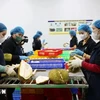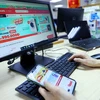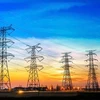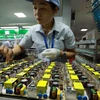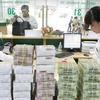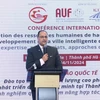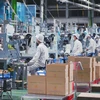A workshop opened in Ho Chi Minh City on October 23 for Vietnamese businesses to improve their sales to export markets in the Middle East .
Held by the Vietnam Chamber of Commerce and Industry (VCCI), the “Key of success for entering the Middle East market” workshop was attended by representatives of the Ministry of Industry and Trade (MoIT), experts from the University of Social Sciences and Humanities, economists and local trading enterprises.
Participants heard the overview introduction of export and import policies in Vietnam and the Middle East , typical features of geography, culture, consumer habits, and business practices of the target export market.
Local businesses were also informed of credit support policies for import/export transactions with the Middle East as well as some critical information to equip them to enter the market.
Ly Quoc Hung, Director of the MoIT’s African-Western & Southern Asian Markets Department, told the meeting that the Middle East is an important market of large and diversified demands for both production and consumer goods.
In addition, the market has a reliable payment capacity thanks to its abundant oil reserve, which is in sharp contrast to its undeveloped production capacity due to a lack of labour and input materials, Hung added.
Vietnam’s exports to the Middle East, which used to be confined to agricultural products--mostly rice and tea--in the past are now expanded to include a wide variety of goods, including computers and electronic parts, textiles and garments, footwear, seafood, coffee, milk and dairy products, rubber and rice.
The MoIT’s project on “Promoting Vietnam-Middle East relations during 2008-2015 period,” approved by the Vietnamese government has identified as a priority the export staples such as agricultural products (rice, tea, coffee, pepper), food (seafood, fruit and vegetables) and fine arts.
Trade and economic relations between Vietnam and Middle East countries have steadily developed in the recent past. Bilateral trade rose to nearly 2 billion USD in 2008 from just over 604 million USD in 2000. Vietnam’s export revenues during the period jumped to 1.25 billion USD from about 414 million USD.
Vietnam imported the largest amount of goods from the Middle East in 2008, with a record value of 744 million USD in 2008. The imports included oil and petroleum, petrochemical products, fertilizers, chemicals, steel, iron and plastics.
According to Director Hung, Vietnam will step up activities to help domestic businesses promote their products to consumers and their partners in the Middle East , including participation in trade fairs, organisation of seminars and business forums as well as working visits for market exploration.
The MoIT will also support local businesses to open representative offices or branches in several markets in the Middle East, he confirmed.
In the past, Vietnam mainly relied on Iraq and the United Emirates of Arab as target markets in the region. Yet today, its goods have found their way into other large markets such as Turkey, Israel and Saudi Arabia./.
Held by the Vietnam Chamber of Commerce and Industry (VCCI), the “Key of success for entering the Middle East market” workshop was attended by representatives of the Ministry of Industry and Trade (MoIT), experts from the University of Social Sciences and Humanities, economists and local trading enterprises.
Participants heard the overview introduction of export and import policies in Vietnam and the Middle East , typical features of geography, culture, consumer habits, and business practices of the target export market.
Local businesses were also informed of credit support policies for import/export transactions with the Middle East as well as some critical information to equip them to enter the market.
Ly Quoc Hung, Director of the MoIT’s African-Western & Southern Asian Markets Department, told the meeting that the Middle East is an important market of large and diversified demands for both production and consumer goods.
In addition, the market has a reliable payment capacity thanks to its abundant oil reserve, which is in sharp contrast to its undeveloped production capacity due to a lack of labour and input materials, Hung added.
Vietnam’s exports to the Middle East, which used to be confined to agricultural products--mostly rice and tea--in the past are now expanded to include a wide variety of goods, including computers and electronic parts, textiles and garments, footwear, seafood, coffee, milk and dairy products, rubber and rice.
The MoIT’s project on “Promoting Vietnam-Middle East relations during 2008-2015 period,” approved by the Vietnamese government has identified as a priority the export staples such as agricultural products (rice, tea, coffee, pepper), food (seafood, fruit and vegetables) and fine arts.
Trade and economic relations between Vietnam and Middle East countries have steadily developed in the recent past. Bilateral trade rose to nearly 2 billion USD in 2008 from just over 604 million USD in 2000. Vietnam’s export revenues during the period jumped to 1.25 billion USD from about 414 million USD.
Vietnam imported the largest amount of goods from the Middle East in 2008, with a record value of 744 million USD in 2008. The imports included oil and petroleum, petrochemical products, fertilizers, chemicals, steel, iron and plastics.
According to Director Hung, Vietnam will step up activities to help domestic businesses promote their products to consumers and their partners in the Middle East , including participation in trade fairs, organisation of seminars and business forums as well as working visits for market exploration.
The MoIT will also support local businesses to open representative offices or branches in several markets in the Middle East, he confirmed.
In the past, Vietnam mainly relied on Iraq and the United Emirates of Arab as target markets in the region. Yet today, its goods have found their way into other large markets such as Turkey, Israel and Saudi Arabia./.




